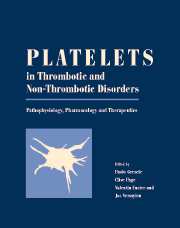Book contents
- Frontmatter
- Contents
- List of contributors
- Editors' preface
- PART I PHYSIOLOGY
- PART II METHODOLOGY
- PART III PATHOLOGY
- PART IV PHARMOLOGY
- PART V THERAPY
- 68 Design of trials to evaluate antiplatelet agents
- 69 Antiplatelet therapy in cardiology
- 70 Antiplatelet therapies in neurology
- 71 Antiplatelet treatment in peripheral vascular disease
- Afterword: Platelets: a personal story
- Index
- Plate section
71 - Antiplatelet treatment in peripheral vascular disease
from PART V - THERAPY
Published online by Cambridge University Press: 10 May 2010
- Frontmatter
- Contents
- List of contributors
- Editors' preface
- PART I PHYSIOLOGY
- PART II METHODOLOGY
- PART III PATHOLOGY
- PART IV PHARMOLOGY
- PART V THERAPY
- 68 Design of trials to evaluate antiplatelet agents
- 69 Antiplatelet therapy in cardiology
- 70 Antiplatelet therapies in neurology
- 71 Antiplatelet treatment in peripheral vascular disease
- Afterword: Platelets: a personal story
- Index
- Plate section
Summary
Progressive atherosclerosis complicated by thromboembolic events is by far the most common cause of peripheral arterial disease. Atherothrombosis, the fashionable term to describe the stenotic/thrombotic process, is a generalized disorder, which is almost invariably ubiquitous and therefore any patient who presents with symptoms or signs suggestive of arterial disease in one vascular bed is likely to have other territories involved as well. The common risk factors for atherosclerosis also apply to peripheral arterial disease, but the order of importance varies: smoking correlates most strongly with disease of the leg arteries and predicts its progression. The disease in the leg arteries remains clinically silent as long as no hemodynamically significant obstructive lesions are formed. Subclinical disease is detected with the aid of simple non-invasive tests in three to four times as many middle-aged adults as is symptomatic disease. Intermittent claudication, leg pain on exercise that is relieved by rest, develops when a drop in driving pressure occurs. Progression of the disease to the extent that the blood flow becomes insufficient to meet the metabolic and nutritional demands of resting tissues is clinically manifested by rest pain and skin lesions at the foot. A Working Group defined chronic critical leg ischemia as the presence of restpain requiring regular analgesia for more than 2 weeks and of an ankle systolic pressure of less than 50 mm Hg (and/or toe systolic pressure of less than 30 mm Hg) with or without skin ulceration or gangrene of toes or foot.
- Type
- Chapter
- Information
- Platelets in Thrombotic and Non-Thrombotic DisordersPathophysiology, Pharmacology and Therapeutics, pp. 1055 - 1062Publisher: Cambridge University PressPrint publication year: 2002



